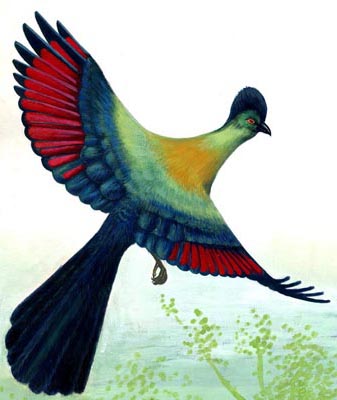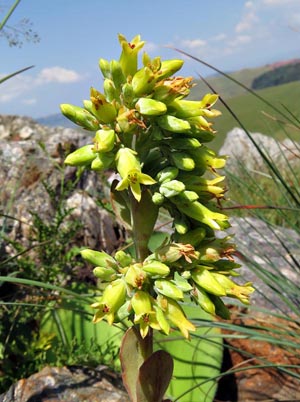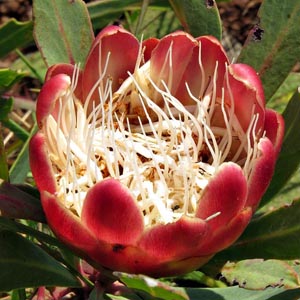The ENTC now has a new website, at www.entc.org.sz
Our logo is adapted from a painting by Phillip Dlamini, 1998, of a purple crested turaco. In traditional Swazi dress, the red feathers feature in the royal headdress, so this bird illustration is not only a symbol for wildlife conservation, but also of cultural heritage.



Information extracted from Southern African Plant Red Data Lists, Ed. Janice Golding, Southern African Botanical Diversity Network Report No. 14, 2002. The links for each species name go to the relevant pages of the Swaziland Flora Database.
Cheirostylis gymnochiloides
Status: CR B1B2cC2b Threats: Mining Distribution: Bomvu Ridge (Ngwenya Mountain - Malolotja) Appears to be extremely rare everywhere. There is apparently only a single collection from Swaziland. Also known from dune forest in South Africa, and as far afield as Tanzania and Madagascar. Flowers from August to September. Iron ore mining is a threat in Swaziland.
Crassula vaginata subsp. minuta
Status: CR A1cB1B2ab Endemism: Near endemic Threats: Urban expansion, habitat degradation Distribution: North of Mbabane (possibly Nkwalini landfill site) Found on rocky granite hills. Could be extirpated in the next five to ten years. Landfill site is a serious threat to locality, seriously threatened. The species is known only from this site in Swaziland.
Encephalartos heenanii
Status: CR A1acdC2a Threats: Collection Distribution: Ngwenya Ridge, Malolotja In 1985, 100 plants were counted. In 1999, only 20 plants could be located. These plants are known from a locality where no recruitment seems to be taking place. A few years ago, this species was also found in a protected area in Swaziland but in very small numbers. Also known from South Africa. Threatened by illegal collectors.
Encephalartos laevifolius
Status: CR A2deB2bD Threats: Pest/disease Distribution: Malolotja In Swaziland, the effects of a pathogen are evident. Threatened by illegal collectors.
Syncolostemon comptonii
Status: CR A1cB1B2a Endemism: Endemic Threats: Damming Distribution: Malolotja, Maguga Threatened by construction of a new dam at Maguga. The species is known from only a single locality.
Warburgia salutaris
Status: CR A1bcd Threats: Collection Distribution: Malolotja, possibly in Lomati Valley Only six trees observed outside protected areas in Swaziland (as reported by conservation authorities in Swaziland). Very few individuals in protected areas, but these are regenerating and are currently not being utilised.
Aloe chortolirioides var. chortolirioides
Status: EN B1B2abC2a Distribution: Bulembu area, Barberton Mountains, Malolotja, Hawane Waterfall, Piggs Peak (gold mine) On rocky open outcops. Is a fire dependent species. listed as Rare for Swaziland in previous RDLs. The red form is found in the Bulembu area. Common between Bulembu (Swaziland) and Barberton Mountains (South Africa). Generally known from Limpopo Province and Mpumalanga in South Africa. Synonyms: Aloe chortolirioides A.Berger var. boastii (Letty) Reynolds
Brachystelma coddii
Status: EN B1B2cC2aD Distribution: Malolotja, Bomvu Ridge, Mbabane, Piggs Peak Three records in Swaziland, including from a protected area, by Compton, Braun and Kemp.
Disa intermedia
Status: EN B1B2cC2a Endemism: Endemic Threats: Habitat degradation Distribution: Forbes Reef, near Mbabane, Malolotja, near Oshoek Grows at an altitude of 1,000 m. Was considered to be common at one time, but due to continued habitat destruction, it is rapidly declining. Flowers in January. Found in highveld grassland.
Melanospermum italae
Status: EN B1B2cC2a Endemism: Near endemic Distribution: Malolotja (Ngwenya Hills), Motjane On sandy places around rock sheets. In South Africa, it is known from the Piet Retief area and Itala.
Melanospermum swazicum
Status: EN B1B2aC2a Endemism: Near endemic Threats: Fire, grazing, habitat degradation Distribution: Mbabane, Malolotja, possibly Ngome, Siphocosini Grows on hills. Subpopulation at Ngome may be a different species. Only one locality known outside Swaziland.
Protea comptonii
Status: EN B1B2cD Endemism: Near endemic? Distribution: Bulembu, Malolotja One outlying subpopulation in KwaZulu Natal (South Africa), although more common in northern and northeastern parts of South Africa.
Prunus africana
Status: EN C2aD Distribution: Near Malolotja (Forbes Reef), near and in Mbabane Also known from South Africa (KwaZulu Natal) and further afield. Is widely utilised for its medicinal purposes.
Siphonochilus aethiopicus
Status: EN A1d Threats: Collection Distribution: Malolotja, Balegane, Komati Valley, Piggs Peak Generally heavily utilised everywhere. Was on the previous Swaziland RDL as Rare. The Malalotja subpopulation is well known and utilised by local herbalists, even though it is located within a protected area. There are unconfirmed reports that several subpopulations are protected from over utilisation through traditional laws, but this cannot be confirmed. Well represented outside Swaziland.
Aloe ecklonis
Status: VU B1B2cD2 Distribution: Malolotja area, Forbes Reef, between Motjane and Oshoek Tips into Swaziland. Mainly a South African distribution. Very common and widespread in South Africa. Synonyms: Aloe kraussii Baker; Aloe boylei Baker
Aloe kniphofioides
Status: VU A2cB1B2c Threats: Collection, harvesting, grazing, fire, urban expansion Distribution: Malolotja, Forbes Reef, Nyonyane Sisa Ranch, Bulembu, Mbabane, Mankayane Grass aloe. Common in Malalotja. Not protected in Forbes Reef. Used in Nyonyane Sisa. Medicinal usage, cattle and resettlement are further threats. Widespread in South Africa.
Dianthus mooiensis subsp. kirkii
Status: VU C1C2a Threats: Collection Distribution: Malolotja, Piggs Peak, Usuthu, Maguga Dam In South Africa, found in the Magaliesberg and Witwatersrand (possibly declining over much of its range). Has horticultural potential. In Swaziland, it is used to make the royal soap for the King. The Swaziland subpopulations are scattered and locally rare. Utilisation is a serious threat.
Encephalartos paucidentatus
Status: VU A1cdC2aD2 Distribution: Makonwya, Malolotja Found in a protected area. The species is found along the Swaziland South African border. Also known from South Africa where it is threatened. Threatened by illegal collectors.
Protea parvula
Status: VU B1B2cC2a Distribution: Timbuti Farm, Hawane, Malolotja Common in the former Transvaal of South Africa.
Streptocarpus wilmsii
Status: VU B1B2c Endemism: Near endemic Threats: Urban expansion Distribution: Devils Bridge, Kings Forest, Mbabane, Hilltop, Ukuthula

Kalanchoe montana

Protea parvula
Our Contacts:
Head Quarters: (+268) 2416 1489/1179
Email: info@sntc.org.sz
King Sobhuza II Park: (+268) 2416 1489/1179
Email: ksmp@sntc.org.sz
National Museum: (+268) 2416 1489/1179
Email: curator@sntc.org.sz
Copyright © ESWATINI NATIONAL TRUST COMMISSION
Malolotja Nature Reserve: (+268) 2444 3241 / (+268) 2416 1480
Email: culturalvillage@sntc.org.sz
Mantenga Nature Reserve and Swati Cultural Village: 2416 1151/1178
Email: culturalvillage@sntc.org.sz
Mlawula Nature Reserve: (+268) 2383 8885 (Reception)
(+268) 2383 8453 (Senior Warden)
Email: culturalvillage@sntc.org.sz
Magadzavane Lodge: (+268) 2343 5108/9
Email: magadzavane@sntc.org.sz